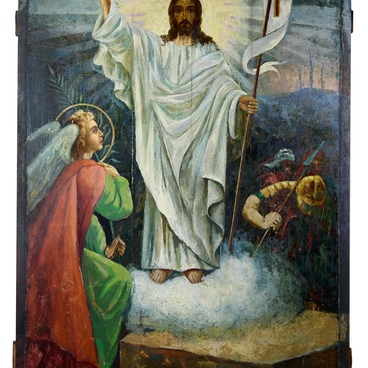Many churches throughout Russia and beyond were built in honor of John Chrysostom, Archbishop of Constantinople and famous theologian of the late 4th and early 5th centuries, and his icon can be seen on almost all iconostases of Orthodox churches. John Chrysostom compiled the main order of the Divine Liturgy, the main Christian service, which is the most common in the Orthodox tradition to this day. For this reason, his icon can often be seen on the altar of the church or on the iconostasis in the tier with other Saints and Church Fathers, on the Holy Gates and even on the sacred vestments.
The exact date of the Saint’s birth is unknown, but there is indirect evidence that he was born in 347 in Antioch. He came from a rather prosperous family. His father was a famous military commander. Thanks to his financial capabilities and talents he received a good education, so that he mastered the skills of rhetoric from a young age and was well versed in philosophy and literature. In 367 he was baptized, which enabled him to participate directly in the divine services. At the age of 50 he became Bishop of Constantinople and was actively engaged in Christian literature. The Saint was convicted for insulting the Empress and on the basis of other false denunciations. He was initially sentenced to death, but his punishment was changed to exile, where he died.
The relics of the saint were first kept in Constantinople. Later they were taken to Rome, where they remained until 2004. Pope John Paul II decided to return them to the Church of Constantinople. They are now housed in Istanbul, in the Cathedral of St. George.
This icon occupied for a long time a rightful place in one of the tiers of the iconostasis of the Church of the Icon of the Mother of God “Joy of All Who Sorrow” in Michurinsk. The iconography of St. John Chrysostom differs little from the general iconography of saints, but in Byzantium it had one distinguishing feature: the saint was depicted with a cross, a sign of martyrdom. John Chrysostom did not suffer at the hands of pagans or heretics; he was a victim of his own brethren and not without the involvement of the authorities.
The exact date of the Saint’s birth is unknown, but there is indirect evidence that he was born in 347 in Antioch. He came from a rather prosperous family. His father was a famous military commander. Thanks to his financial capabilities and talents he received a good education, so that he mastered the skills of rhetoric from a young age and was well versed in philosophy and literature. In 367 he was baptized, which enabled him to participate directly in the divine services. At the age of 50 he became Bishop of Constantinople and was actively engaged in Christian literature. The Saint was convicted for insulting the Empress and on the basis of other false denunciations. He was initially sentenced to death, but his punishment was changed to exile, where he died.
The relics of the saint were first kept in Constantinople. Later they were taken to Rome, where they remained until 2004. Pope John Paul II decided to return them to the Church of Constantinople. They are now housed in Istanbul, in the Cathedral of St. George.
This icon occupied for a long time a rightful place in one of the tiers of the iconostasis of the Church of the Icon of the Mother of God “Joy of All Who Sorrow” in Michurinsk. The iconography of St. John Chrysostom differs little from the general iconography of saints, but in Byzantium it had one distinguishing feature: the saint was depicted with a cross, a sign of martyrdom. John Chrysostom did not suffer at the hands of pagans or heretics; he was a victim of his own brethren and not without the involvement of the authorities.



